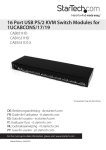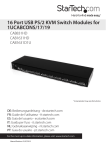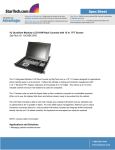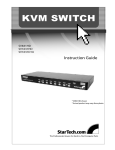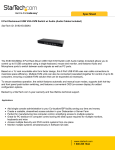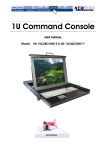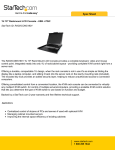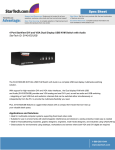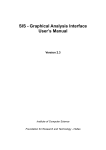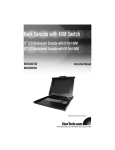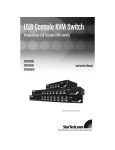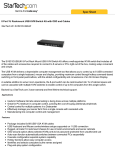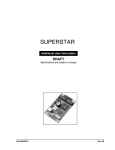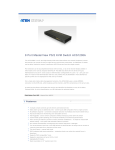Download KVM SWITCH
Transcript
KVM SWITCH CAB831HD CAB1631HD CAB1631D1U Instruction Guide * CAB1631D1U shown * Actual product may vary from photo The Professionalsí Source For Hard-to-Find Computer Parts Table of Contents Introduction ................................................................................................2 System Requirements ................................................................................2 Installation ..................................................................................................3 Operating Your KVM Switch.......................................................................4 Pushbuttons ...............................................................................................4 OSD Operations.........................................................................................4 OSD Function Keys....................................................................................5 Hot Key Commands ...................................................................................8 Changing Your Configuration .....................................................................9 Keyboard Mapping ...................................................................................10 Troubleshooting .......................................................................................11 Technical Specifications...........................................................................12 Technical Support ....................................................................................13 Warranty Information................................................................................13 2 Introduction Thank you for purchasing a StarTech.com 1U KVM module. Designed for use with StarTech.com’s CABCONS or CABCONS17 integrated cabinet consoles, these KVMs allow you to control your PCs from one convenient location. Our universal KVM switches let you control either 8 (CAB831HD) or 16 (CAB1631HD) USB or PS/2 computers. Our slim 16-port PS/2 switch (CAB1631D1U) lets you connect 16 PS/2 computers. These slim KVM switches take up only 1U of space in your cabinet and use rear cable connections for maximum space efficiency. Each KVM can be cascaded to support 64 (CAB831HD) or 136 (CAB1631HD, CAB1631D1U) computers and support both Manual and Auto scan modes for easy monitoring of your PCs. Features • • • • • • • • • • • • CAB831HD, CAB1631HD: Supports PCs with both USB and PS/2 keyboard/mouse connections CAB1631D1U: Supports PCs with PS/2 keyboard/mouse connections Saves valuable rack space with thin 1U height form factor Supports hot-plugging: allows computers to be added or removed without having to reboot the other connected systems CAB831HD, CAB1631HD: Works with PC, Mac, and Sun systems Fast switch-buttons for each port provide quick access to any connected system Uses On-Screen Display (OSD) menu for easy PC selection and switch configuration Can be cascaded to control up to 64 (CAB831HD) or 136 (CAB1631HD, CAB1631D1U) PCs Allows effortless monitoring of devices through configurable Auto and Manual scan modes Acts independent of operating system: no software or drivers required Complies with Plug and Play specifications Backed by StarTech.com’s 3-year warranty Before You Begin To ensure a quick and easy console installation, please read through this section carefully before attempting to install the device. Contents This package should contain: • 1 x StarView KVM Switch (CAB831HD, CAB1631HD, CAB1631D1U) System Requirements • • • 1 x StarTech.com 1UCABCONS or 1UCABCONS17 CAB831HD, CAB1631HD: StarTech.com’s 2-in-1 USB KVM cables or 3-in-1 PS/2 KVM cables CAB1631D1U: StarTech.com’s 3-in-1 PS/2 KVM cables 3 Installation This section will guide you through the hardware installation of your KVM switch. Please read through this section carefully and complete each step in the order listed. 1. 2. 3. 4. Make sure all computers and devices are powered off. Connect your KVM module to your 1UCABCONS or 1UCABCONS17 as directed in their user guides. Attach each of your managed computers to your StarView KVM console’s PC ports using ultra-thin KVM cables. The CAB831HD and CAB1631HD are capable of using either 2-in-1 USB or 3-in-1 PS/2 cables. The CAB1631D1U uses 3-in-1 PS/2 cables. Use the cables to connect one of the PC ports on the back of the switch to the computer's keyboard, mouse, and video ports. Note: These instructions are for a single KVM switch only. For information on cascading multiple KVMs, see Cascade Configuration below. Turn on your computers. Note: After the initial power up, you can hot-plug additional computers or slave KVM switches without having to power down your KVM. Cascade Configuration You can connect a second level of KVMs to one or more of your Master KVM switch’s PC ports. The KVM switches connected to the Master switch are know as Slaves. Once connected, the KVM switches will automatically configure themselves as either Masters or Slaves. You can only connect an equal or “smaller” KVM to the Master KVM. For example, a 16-port Master KVM switch can have both 16-port and 8-port slaves. An 8-port Master KVM switch can only have 8-port KVM slaves or lower. The 8-port KVM can support 64 PCs, with 8 8-port Slave KVMs, each connected to 8 PCs. The 16-port KVMs can support 136 computers, with 8 16-port Slave KVMs, each connected to 16 computers. The Slave KVMs must be connected to the 1~8 ports, not the A~H ports. To cascade your KVMs, use a 3-in-1 PS/2 KVM cable to connect one of your Master switch’s PC ports to the Slave switch’s PC 1~8 ports. A slave KVM module may be mounted to the rear vertical poles inside a rack cabinet by the rear brackets with the connectors facing out. The connectors (keyboard and mouse) at the Local port on the rear of the KVM module are not applicable when the module is connected to the drawer by the C-36 connector. When its C-36 connector is not connected to the drawer, the KVM module can act as a rear-mount stand-alone KVM switch. The Local VGA port can be connected to an external VGA monitor at any time. 4 Operating Your KVM Switch To toggle between computers, you can use the hot-key commands, OSD (On-Screen Display) menu or by using the pushbuttons. Push Buttons A solid red indicator reflects the port selected. The indicator flashes red when in Auto or Manual Scan mode. You can press any of the corresponding pushbuttons to select the active computer. On the 16 port models, Port 1 and Port A share the same pushbutton, as do Port 2 and Port B, etc. To select Ports 1 through 8, press the pushbutton once. To select Ports A through H, press and hold the pushbutton for two seconds. Alternatively, if Port 1 is currently selected and you want to select Port A, you can press the pushbutton once to switch to Port A. The K/M Reset function reconfigures your system without powering down your computers or your KVM switch. To reset the switch, press and hold the front-panel 1 and 2 buttons simultaneously. The Auto-Scan function automatically scrolls through your connected computers. Press and hold the frontpanel 7 and 8 buttons simultaneously to enter Auto Scan mode. OSD Operations By hitting the left <CTRL> key twice within two seconds, you may see the 'Hotkey Menu' if it is enabled (an OSD option). Or, by hitting the left <CTRL> key three times within two seconds, you will see a 'KVM MENU' screen (below) showing a list of the computers with corresponding channel addresses, names and status. 5 • The port number (or channel address) of the currently selected computer is displayed in red in the top right of the screen. • The device name is green if the device has power and is ready for selection or white if it has no power. The OSD menu automatically updates the color when it is activated. On the 16-port models, use the <Page Up> and <Page Down> keys to view the other 8 computers. • Use the <UP>, <DOWN>, 1~8, or A~H keys to highlight a computer and <ENTER> to select it. • Press <ESCAPE> to exit the OSD menu and remove the OSD menu from the screen. • A triangle mark on the right side of the screen indicates the port is cascaded to a Slave KVM; the number at the left of the triangle mark shows the number of ports the Slave has. With that port highlighted, press <ENTER> to bring up a screen listing the computers connected to that Slave. The name of the Slave KVM will be shown at the upper right corner of the OSD menu. • An eye mark on the right side of the screen indicates that the computer has been selected to be monitored in Scan mode. You can switch this mark on and off using function key <F2>. • Press <ESCAPE> to exit the OSD and to return to using the selected computer. The computer name is shown on the screen. OSD Function Keys You can use the function keys when the OSD menu is active. Function key <F1> Edits the name of a computer or a Slave KVM. First, use the <UP> and <DOWN> arrow keys to highlight a channel then press <F1> followed by name entry. Your name can be up to 14 characters long. Valid characters are A to Z, 0 to 9, and the dash character. Lowercase letters are converted to uppercase. Press <BACKSPACE> to delete a letter one at a time. Non-volatile memory stores all name entries until you change, even if the unit is powered down. Function key <F2> Marks a computer to be scanned by switching the eye mark on or off. First, use the <UP> and <DOWN> arrow keys to highlight the device, then press <F2> to switch its eye mark on or off. If Scan Type is Ready PC + Eye (see Function key <F4>), only the powered and eye-marked computers will be displayed in Scan mode. 6 Function key <F3> Locks a device (a computer or a Slave) from unauthorized access. To lock a device, use the <UP> and <DOWN> arrow keys to highlight it, then press <F3>. Now, enter up to 4 characters (A to Z, 0 to 9, dash) followed by <ENTER> as new password. A Security-enabled device is marked with a lock beside its channel number. To permanently disable the security function from a locked device, highlight it, press <F3> then enter the password. If you want to access the locked device temporarily, simply highlight it and press <ENTER>. Enter the password and you can access the device. The device is automatically re-locked once you switch to another device. During Scan mode, OSD skips the security-enabled device. If you forget the password, the only way to permanently erase all passwords is to press and hold pushbuttons 1 and 2, then press and hold pushbuttons 7 and 8. Release 7 and 8 then release 1 and 2. Function key <F4> More functions are available by hitting <F4>. A new screen pops up displaying the functions described below. Most of them are marked with a triangle indicating there are options to choose from. Using the <UP> and <DOWN> arrow keys, select the function and press <ENTER>. Available options will be shown in the middle of the screen. To select an option, use the <UP> and <DOWN> arrow keys then press <ENTER> to select the option. You can press <ESCAPE> to exit at any time. Auto Scan In this mode, the KVM automatically switches from one power-on computer to the next sequentially in a fixed interval. During Auto Scan mode, the OSD displays the name of the selected computer. When Auto Scan detects any keyboard or mouse activity, it suspends the scanning until activity stops; it then resumes with the next computer in sequence. To abort Auto Scan mode, press the left <CTRL> twice, or press any front button. Scan Type and Scan Rate set the scan pattern. Scan Type (<F4>: More\Scan Type) determines if scanned computers must also be eye mark selected. Scan Rate (<F4>: More\Scan Rate) sets the display interval when a computer is selected before selecting the next one. Manual Scan Scans through power-on computers using keyboard control. Scan Type (<F4>: More\Scan Type) determines if scanned computers must also be eye mark selected. Press the up arrow key to select the previous computer and the down arrow key to select the next computer. Press any other key to abort the Manual Scan mode. Audio Stick An optional multimedia module can be LINKed to the back of each StarView for selecting microphone and stereo speaker signals. There are two options for Audio Stick: On and Off. When set to On, audio selection follows computer selection. When set to Off, audio selection stops following computer selection. Off mode is useful if you want to listen to a particular computer's audio signal while operating other computers. The non-volatile memory stores the Audio Stick setting. Scan Type Ready PC + Eye: In Scan mode, scans through only power-on and eye-marked selected computers. Ready PC: In Scan mode, scans through all power-on computers. Eye only: In Scan mode, scans through any Eye-selected computer regardless of power status. The non-volatile memory stores the Scan Type setting. Scan Rate Sets the duration of a computer displayed in Auto Scan mode. The options are 3 seconds, 8 seconds, 15 seconds and 30 seconds. The non-volatile memory stores the Scan Rate setting. 7 Keyboard Speed StarView offers a keyboard typematic setting that overrides the typematic settings in the BIOS and Windows operating system. Available speed options are Low, Middle, Fast and Faster as 10, 15, 20 and 30 characters/sec respectively. The non-volatile memory stores the Keyboard Speed setting. Hotkey Menu When you hit the left <CTRL> key twice within two seconds, the Hotkey Menu appears displaying a list of hot-key commands if the option is On. The Hotkey Menu can be turned Off if you prefer not to see it when the left <CTRL> key is hit twice. The non-volatile memory stores the Hotkey Menu setting. CH Display Auto Off: After you select a computer, the channel address and name of the computer will appear on the screen for 3 seconds then disappear automatically. Always On: The channel address and name of a selected computer and/or OSD status displayed on the screen all the time. The non-volatile memory stores the CH Display setting. Position You can choose where the selected computer name and/or OSD status is displayed on your screen during operation. The actual display position shifts due to different VGA resolution, the higher the resolution the higher the display position. The non-volatile memory stores the Position setting. UL as Upper Left UR as Upper Right LL as Lower Left LR as Lower Right MI as Middle Country Code for Sun (CAB831HD, CAB1631HD only) Sun keyboards of different languages have different layouts. This KVM switch can emulate a Sun keyboard for a specific language type (or country). Select the proper country code that matches all your Sun computers. Function Key <F5> (CAB831HD, CAB1631HD only) Switches the Sun mark on or off. The Sun mark indicates that the port is connected to a Sun server. First, use the <UP> and <DOWN> arrow keys to highlight the device, then press <F5> to switch its Sun mark on or off. When a Sun-marked port is selected, the KVM will translate the keys from a PS/2 keyboard to a Sun keyboard. For more information see Keyboard Mapping on page 10. ESC: To exit the OSD, press the <ESCAPE> key 8 Hot Key Commands A hot key command is a short keyboard sequence to select a computer, activate a computer scan, etc. A hot-key sequence starts with two Left Control keystrokes followed by one or two more keystrokes. A built-in buzzer generates a high-pitched beep for correct hot-key sequences and a low-pitched beep for errors or bad key combinations that will not be carried out. The short form hot-key menu can be turned on as an OSD function (<F4>: More\Hotkey Menu) every time the left <CTRL> key is pressed twice. • • Left Ctrl refers to the <CTRL> key located at the left side of the keyboard. 1~8/A~H refer to the number keys 1 to 8 at the upper row of the keyboard (Do not use the keypad at the right of the keyboard) and character keys A to H (case insensitive). Selecting a Computer To select a computer by hot-key command you need to know the device’s channel address, which is determined by the StarView connection. • For a computer connected to a Master KVM, the address is represented by the PC port number (1~8 or A~H). For example, to access the PC plugged into port 7 of the Master KVM switch, type: left Ctrl + left Ctrl + 7 • For a computer connected to a Slave KVM, you need to know the channel address of the Slave unit (1~8) and then the channel address of the device (1~8 or A~H). (Please note that only Master's PC 1 to PC 8 ports can be connected to a Slave.) For example, to access the computer plugged into port C of the Slave KVM Switch that is plugged into Port 6 of the Master KVM, type: left Ctrl + left Ctrl + 6 + C Auto Scan Auto Scan automatically scans through power-on computers at a fixed interval: left Ctrl + left Ctrl + F1 When Auto Scan detects any keyboard or mouse activity, it suspends the scanning until activity stops; it then resumes with the next computer in sequence. The length of the Auto Scan interval (Scan Rate) is adjustable (see Scan Rate on the following page). To abort the Auto Scan mode, press the left Ctrl key twice. Note: Scan Type (See “OSD Function Keys: F4”) determines whether eye mark is necessary during Auto Scan. Manual Scan Manual Scan enables you to manually switch back and forth between power-on computers: left Ctrl + left Ctrl + F2 Press the up or down arrow to select the previous or next computer in sequence. Press any other key to abort the Manual Scan. Note: Scan Type (See “OSD Function Keys: F4”) determines whether eye mark is necessary during Manual Scan. 9 Scan Rate Scan Rate sets the duration between switching to the next computer in Auto Scan mode: left Ctrl + left Ctrl + F3 The StarView gives off one to four beeps indicating scan interval of 3, 8, 15 and 30 seconds respectively. Keyboard Typematic Rate You can adjust the keyboard typematic rate (given in characters/sec). This setting over-rides the keyboard typematic rate of your BIOS and any operating system. left Ctrl + left Ctrl + F4 The StarView gives off 1 to 4 beeps indicating 10, 15, 20 and 30 characters/sec respectively. Audio Stick An optional multimedia module can be LINKed to the back of each StarView for selecting microphone and stereo speaker signals. There are two options for Audio Stick: On and Off. When set to On, audio selection follows computer selection. When set to Off, audio selection stops following computer selection. It is useful if you want to listen to a particular computer's audio signal while operating other computers. left Ctrl + left Ctrl + F5 The StarView gives off 1 or 2 beeps corresponding to On and Off respectively. Changing Your Configuration After the initial power up, any device (either a KVM or a PC) can be added or removed from any PC x port on the KVM without having to power down the Master KVM Switch. Make sure that devices are turned off before connecting them to the Master KVM switch. Note: After changing your configuration, the OSD will automatically update to reflect the new configuration. 10 Keyboard Mapping (CAB831HD, CAB1631HD only) These KVMs are able to emulate a Sun keyboard and mouse when a computer is marked with a Sun in OSD menu by Function key <F5>. A Sun keyboard has more keys than a standard PS/2 keyboard. These extra keys are simulated by tapping the lower-right Ctrl followed by one of the function keys on the PS/2 keyboard (i.e. combo key). For instance, tap the lower-right Ctrl key, and then tap the function key F7 to activate Open for a Sun computer. From PS/2 keyboard Map to Sun keyboard Map to Mac keyboard right - Ctrl 1 right - Ctrl 2 right - Ctrl 3 note right - Ctrl 4 right - Ctrl F1 Power Stop right - Ctrl F2 Again right - Ctrl F3 Props right - Ctrl F4 Undo right - Ctrl F5 Front right - Ctrl F6 Copy right - Ctrl F7 Open right - Ctrl F8 Paste right - Ctrl F9 Find right - Ctrl F10 Cut Print Screen F13 Scroll Lock F14 Pause Break F15 right - Ctrl H Help right - right - ® right - left - left - ® left - Context key Compose right - Alt Alt Graph right - Option left - Alt Alt left - Option Note: For Sun: The switch does not support LowPower option under Power Off Select after the command right - Ctrl 4. * For Japanese keyboard: The leading key for the Combo Key is replaced by . 11 Troubleshooting If you are experiencing trouble with your devices, first make sure that all cables are connected to their proper ports and are firmly seated. You may also want to try resetting the devices by pressing and holding the front-panel 1 and 2 pushbuttons. Nothing works. • There may be a bad C-36 connection. Push the console and the KVM switch firmly together, leaving only 5/16” (8mm) between the two. Make sure they are properly secured with the screws. Monitor works, but keyboard and touch pad do not. • Another keyboard or mouse may be connected to the Local ports on the KVM. If the KVM is connected to a console through the C-36 connector, the Local ports should not be connected to anything. No OSD screen or screen image. • You may have selected a power-off computer. Use the pushbuttons or to select a computer that is turned on. Also make sure that the KVM is properly connected to a power source. The letters on the TFT LCD display are blurry or have shadows. • You may have improper resolution settings. Under the Control Panel, set the VGA output of your computers to match the highest resolution of the LCD monitor with “Large Font” selected. Master/Slave does not work or there is a double OSD. • Make sure that the slave’s Console port is connected to one of the Master’s PC ports. • Perform a KVM Reset. • Make sure that you have removed all power sources from the Slave unit before connecting it to the Master KVM switch. The Up and Down arrows don’t work in manual scan mode. • Make sure more than one computer is turned on. Manual Scan only works with power-on computers. • Check the Scan Type (from the OSD menu) and make sure you have selected the proper computers. Auto Scan does not work, the StarView beeps and the indicators flash red. • Make sure more than one computer is turned on. Auto Scan only works with powered on computers. • Check the Scan Type (from the OSD menu) and make sure you have selected the proper computers. • Press the Left Control key twice or press any front pushbutton to abort the Auto Scan. OSD menu is not in the proper position. • The OSD menu has a fixed resolution and its size varies depending on the monitor. Use <F4> More/ Position (from the OSD menu) to move the OSD menu to a different location. Cannot select a computer connected to a Slave. • Make sure that the Slave’s Console port is connected to one of the Master’s PC ports. • Only ports PC1 to PC8 can be connected to Slaves, even if the Master KVM has 16 PC ports. • Only one level of Slave KVMs is allowed. Keyboard strokes are shifted. • Press both Shift keys. 12 Technical Specifications CAB831HD CAB1631HD CAB1631D1U User ports 1 1 1 Computer ports 8 16 16 Up to 64 Up to 136 Up to 136 2-in-1 USB KVM 3-in-1 PS/2 KVM 2-in-1 USB KVM 3-in-1 PS/2 KVM 3-in-1 PS/2 KVM On-Screen Display Yes Yes Yes Hot plug and play Yes Yes Yes Hot key control Yes Yes Yes Rack mountable 19” industry standard 19” industry standard 19” industry standard 3, 8, 15, 30 seconds 3, 8, 15, 30 seconds 3, 8, 15, 30 seconds Yes Yes Yes 100 ft (30m) at Console PS/2: 100 ft (30m) at PC USB: 16 ft (5m) at PC 100 ft (30m) at Console PS/2: 100 ft (30m) at PC USB: 16 ft (5m) at PC 100 ft (30m) at Console PS/2: 100 ft (30m) at PC 1920x1440, DDC2B 1920x1440, DDC2B 1920x1440, DDC2B C-36 C-36 C-36 Computer Connector 8 x HD-DB-15 female 16 x HD-DB-15 female 16 x HD-DB-15 female Console Connectors: Mouse Keyboard Monitor 1 x PS/2 female 1 x PS/2 female 1 x HD-DB-15 female 1 x PS/2 female 1 x PS/2 female 1 x HD-DB-15 female 1 x PS/2 female 1 x PS/2 female 1 x HD-DB-15 female 1.6 x 15.9 x 4.5 in. (40 x 404 x 114 mm) 1.6 x 15.9 x 4.5 in. (40 x 404 x 114 mm) 1.6 x 15.9 x 4.5 in (40 x 404 x 114 mm) Cascade control PC number Cable Type Auto scan interval Programmable scan pattern Cable length (max.) VGA TFT LCD VGA Connector Dimensions (H x W x D) 13 Technical Support The following technical resources are available for this StarTech.com product: On-line help: We are constantly adding new information to the Tech Support section of our web site. To access this page, click the Tech Support link on our homepage, www.startech.com. In the tech support section there are a number of options that can provide assistance with this card. Knowledge Base - This tool allows you to search for answers to common issues using key words that describe the product and your issue. FAQ - This tool provides quick answers to the top questions asked by our customers. Downloads - This selection takes you to our driver download page where you can find the latest drivers for this product. Call StarTech.com tech support for help: USA/Canada: 1-519-455-4931 UK/Ireland/Europe: 00-800-7827-8324 Support hours: Monday to Friday 9:00AM to 5:00PM EST (except holidays) Warranty Information This product is backed by a three-year warranty. In addition StarTech.com warrants its products against defects in materials and workmanship for the periods noted below, following the initial date of purchase. During this period, the products may be returned for repair, or replacement with equivalent products at our discretion. The warranty covers parts and labor costs only. StarTech.com does not warrant its products from defects or damages arising from misuse, abuse, alteration, or normal wear and tear. Limitation of Liability In no event shall the liability to StarTech.com Ltd. (or its officers, directors, employees or agents) for any damages (whether direct or indirect, special, punitive incidental, consequential, or otherwise), loss of profits, loss of business, or any pecuniary loss, arising out of related to the use of the product exceed the actual price paid for the product. Some states do not allow the exclusion or limitation of incidental or consequential damages. If such laws apply, the limitations or exclusions contained in this statement may not apply to you. FCC Compliance This device complies with part 15 of the FCC Rules. Operation is subject to the following conditions: (1) this device may not cause harmful interference; and (2) this device must accept any interference received, including interference that may cause undesired operation. November 3, 2003
















